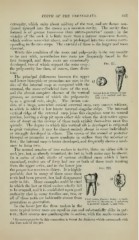Page 433 - My FlipBook
P. 433
TEETH OF THE VERTEBRATA. 443
extremity, which unite about midway of the root, and are thence con-
tinued upward into the crown as a common cavity. The cavity thus
formed is of greater transverse than antero-posterior ^ extent; in the
vicinity of the neck it is httle more than a narrow transverse fissure,
which widens somewhat above, and is prolonged into two cornua corre-
sponding to the two cusps. The external of these is the larger and most
elevated.
While this condition of the roots and pulp-cavity is the one usually
to be met with, nevertheless two roots are frequently found in the
first bicuspid, and three roots are occasionally
developed, two of which support the outer cusp Fig. 221.
;
the pulp-cavity has then, of course, three divis-
ions.
The principal differences between the upper
and lower bicuspids or premolars are seen in the
size of the internal cusp as compared with the
external, the more cylindrical form of the root,
and the almost complete absence of the vertical Second Lower Human Hicus-
pid : n, li, vertical and lat-
grooves, on account of which the pulp-cavity eral views.
is, as a general rule, single. The crown con-
sists of a large, somewhat conical external cusp, very convex without,
to which is added a low lunate internal cingular ridge. The internal
vertical ridge of the external cusp joins this cingulum near its central
portion, leaving a deep pit upon either side where the destructive agen-
cies of decay on the crowns of these teeth exhibit themselves most fre-
quently. The degree to which this vertical rib is developed is subjected
to great variation ; it may be almost entirely absent in some individuals
or strongly developed in others. The crown of the second or posterior
bicuspid or premolar is more quadrate in outline than the anterior or
first ; the internal cusp is better developed, and frequently shows a tend-
ency to form two.
The normal number of true molars is twelve, three on either side in
each jaw, but, as already remarked, the last in both series may be absent.
In a series of- adult skulls of various civilized races which I have
examined, twelve out of forty had one or both of these teeth wanting
from the upper series, and in the lower jaw
Fig.
the proportion was ten to thirty. It is highly
probable that in many of these cases these
teetli had been j^resent, but had disappeared
early in life. Many examples could be cited
in which the last or third molars wholly fail
to be erupted, and it is established upon good
authority that in many families one, two, or
all of these teeth are habitually absent from
I'irst Lower Human Molar : a, verti-
generation to generation. cal view of the crown ; 1. anterior;
2, postal ioi- aspect; l>, side view.
In the lower jaw the three molars in the
more typical lower races are equal in size and sub.stantially alike in pat-
tern ; their crowns are quadrangular in section, with the angles consider-
^ By antero-posierior in this connection is meant the diameter whicli corresponds with
ihe long axis of the jaw.


